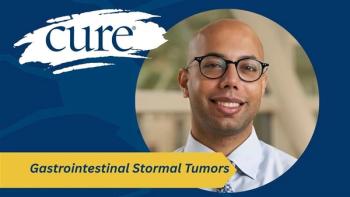
Trodelvy/Keytruda Extends PFS Versus Chemo/Keytruda in PD -L1+ TNBC
Key Takeaways
- Trodelvy plus Keytruda improved progression-free survival in PD-L1–positive, advanced TNBC, reducing disease progression or death risk by 35% compared to chemotherapy plus Keytruda.
- The phase 3 ASCENT-04/KEYNOTE-D19 trial showed a median progression-free survival of 11.2 months for Trodelvy plus Keytruda versus 7.8 months for chemotherapy plus Keytruda.
Trodelvy plus Keytruda, when given in the frontline, extended survival without progression versus chemo plus Keytruda in PD-L1+ metastatic TNBC.
Trodelvy (sacituzumab govitecan-hziy) and Keytruda (pembrolizumab), when given as a first-line treatment, significantly improved survival without progression versus chemo plus Keytruda among patients with PD-L1–positive, advanced or metastatic triple-negative breast cancer (TNBC).
These primary findings were generated from the phase 3 ASCENT-04/KEYNOTE-D19, which were shared during the
At a data cutoff date of March 3, 2025, out of the 221 patients treated with Trodelvy plus Keytruda, there was a median progression-free survival of 11.2 months by blinded independent central review (BICR) versus 7.8 months in the 222 patients treated with chemotherapy plus Keytruda, translating to a 35% reduction in the risk of disease progression or death. The six- and 12-month progression-free survival rates in the Trodelvy arm were 72% and 48%, respectively; in the chemotherapy arm, these respective rates were 63% and 33%.
“Results from ASCENT-04/KEYNOTE-D19 support the use of Trodelvy plus Keytruda as a potential new standard of care for patients with previously untreated, PD-L1–positive, locally advanced unresectable or metastatic TNBC,” Dr. Sara M. Tolaney, chief of the division of Breast Oncology at Dana-Farber Cancer Institute, in Boston, Massachusetts, said in the briefing. She is also an associate professor of medicine at Harvard Medical School.
Unmet Needs Paving the Path to ASCENT-04
Data from previous studies showed that median progression-free survival achieved with chemotherapy with immune checkpoint inhibition ranges from 7.5 months to 9.7 months in patients with PD-L1–positive metastatic TNBC; however, most patients will experience progressive disease and approximately half of those treatment for metastatic TNBC in the first line do not go on to receive second-line treatment.
Trial Design: Eligibility, Treatment, Objectives
The global, randomized, phase 3 study enrolled patients with treatment-naive, locally advanced unresectable or metastatic TNBC who had PD-L1 positivity defined as a combined positive score of at least ten per the 22C3 assay. At least six months must have passed since treatment in the curative setting, where prior anti–PD-(L)1 inhibition was permitted.
A total of 443 participants were randomly assigned to receive either 10 milligrams per kilogram (mg/kg) of intravenous Trodelvy on days one and eight, plus 200 mg of Keytruda on day one of 21-day treatment cycles versus Keytruda at the same dose and schedule combined with chemotherapy. Treatment continued until progressive disease and intolerable toxicity. All patients who experienced disease progression by BICR were permitted to cross over to receive single-agent Trodelvy in the second line.
Stratification factors comprised region (US/Canada/Western Europe vs the rest of the world), previous exposure to PD-(L)1 inhibition (yes versus no), and curative treatment-free interval (de novo TNBC versus recurrence within six to 12 months from treatment completion in the curative setting versus recurrence longer than 12 months from completion of treatment in the curative setting).
The primary end point of the study was progression-free survival by BICR, and secondary end points included overall survival, objective response rate and duration of response by BICR, safety and quality of life.
All patients were female and had a PD-L1 combined positive score of 10 or higher. Most patients were White (Trodelvy arm, 63%; chemotherapy arm, 63%), from the rest of the world (62%; 62%) and had an ECOG performance status of 0 (71%; 69%). Regarding curative treatment-free interval, most patients were recurrent in over 12 months (48%; 48%), followed by de novo (34%; 34%) and recurrent within 6 to 12 months (18%; 18%). Metastatic sites included lymph nodes (72%; 69%), lung (50%; 43%), other (37%; 32%), bone (28%; 20%), liver (25%; 26%) and brain (4%; 3%).
The chemotherapy selected before randomization in the Trodelvy arm was taxane for 52% of patients and gemcitabine/carboplatin for 48% of patients; in the chemotherapy arm, these respective rates were 51% and 49%. Four percent of patients in the antibody-drug conjugate arm vs 5% of those in the chemotherapy arm had prior exposure to PD-(L)1 inhibition.
Additional Efficacy Revelations
Although overall survival data were immature at the time of the report, with a maturity rate of only 26%, a positive improvement was observed for the Trodelvy plus Keytruda arm vs chemotherapy plus Keytruda arm — despite a high crossover rate. Specifically, 43% of those on the chemotherapy arm crossed over to receive the antibody-drug conjugate as a single agent in the second line, which accounted for 81% of those who were subsequently given treatment after chemotherapy/Keytruda was discontinued.
The median overall survival was not reached in the Trodelvy arm, and it was also not reached in the chemotherapy arm; 53 and 61 events were reported in the arms, respectively. The hazard ratio for overall survival was 0.89.
Trodelvy plus Keytruda induced an objective response rate of 60% vs 53% with chemotherapy plus Keytruda. In the antibody-drug conjugate arm, 13% of patients achieved a complete response and 47% had a partial response; 32% had stable disease, 4% progressed and 5% were not response evaluable. In the chemotherapy arm, the complete response and partial response rates were 8% and 45%, respectively; 32% of patients had stable disease, 12% experienced disease progression and 4% were not evaluable.
The median time to response in the Trodelvy arm was 1.9 months (range, 1.0-9.3); it was also 1.9 months (range, 1.1-11.4) in the chemotherapy arm. Notably, the median duration of response was 16.5 months in the antibody-drug conjugate arm and 9.2 months in the chemotherapy arm.
Safety Spotlight
Any-grade treatment-emergent side effects occurred in over 99% of those in the Trodelvy and chemotherapy arms; these effects were grade 3 or higher for 71% and 70% of patients, respectively. Treatment-emergent serious side effects were experienced by 38% of those who received the antibody-drug conjugate vs 31% of those given chemotherapy; 28% and 19% of cases, respectively, were treatment related.
In the Trodelvy plus Keytruda arm, treatment-emergent side effects led to dose reductions or interruptions in 35% and 77% of patients, respectively; treatment-emergent side effects led to treatment discontinuation for 12% of patients and proved fatal for 3% of patients. Three of the 7 treatment-emergent side effects that led to death were determined to be related to treatment. In the chemotherapy plus Keytruda arm, treatment-emergent side effects led to dose reductions and interruptions for 44% and 74% of patients, respectively; treatment-emergent side effects led to discontinuation for 31% of patients. treatment-emergent side effects led to death for 3% of those in this arm; 1 of these cases was related to treatment.
“Overall, the safety profile of Trodelvy plus Keytruda was consistent with the known safety profiles of each drug,” Tolaney said. “The rate of serious side effects was higher in the Trodelvy plus Keytruda group compared with the chemotherapy plus Keytruda group; however, the rate of treatment-emergent side effects leading to dose reduction or treatment discontinuation was lower.”
Topline Takeaway
Dr. Jane L. Meisel, professor in the Departments of Hematology and Medical Oncology and Gynecology & Obstetrics, and codirector of Breast Medical Oncology at Emory University School of Medicine in Georgia, commented on the significance of the findings.
“I do think this is really such potentially practice-changing data. We've seen in previous studies how Trodelvy works so well for patients with metastatic TNBC later on in their treatment. And now, to see this combined with Keytruda and compared with chemotherapy plus Keytruda with such both statistically and clinically meaningful benefits for patients, I think it really does change the game for this subgroup,” she said. “This is very exciting, and I look forward to seeing this potentially make its way into clinical practice. I think the nice thing too, is that as clinicians, many of us have used both of these agents — Trodelvy and Keytruda — quite a bit, and so the fact that there were no additional toxicities seen [beyond what we have] seen before, will help people get used to using this and feel comfortable with it once it makes its way into the clinic.”
Reference
Tolaney SM, de Azambuja E, Kalinsky K, et al. Sacituzumab govitecan (SG) + pembrolizumab (pembro) vs chemotherapy (chemo) + pembro in previously untreated PD-L1–positive advanced triple-negative breast cancer (TNBC): Primary results from the randomized phase 3 ASCENT-04/KEYNOTE-D19 study. J Clin Oncol. 2025;43(suppl 17):LBA109. doi:10.1200/JCO.2025.43.17_suppl.LBA109
For more news on cancer updates, research and education, don’t forget to





